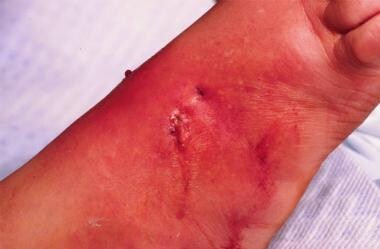Background
Pasteurella multocida is a small, gram-negative, nonmotile, non–spore-forming coccobacillus with bipolar staining features. The bacteria typically appear as single bacilli on Gram stain; however, pairs and short chains also can be seen. P multocida often exists as a commensal in the upper respiratory tracts of many livestock, poultry, and domestic pet species, especially cats and dogs. In fact, Pasteurella species are some of the most prevalent commensal bacteria present in domestic and wild animals worldwide. [1, 2] P multocida infection in humans often is associated with an animal bite, scratch, or lick, but infection without epidemiologic evidence of animal contact may occur. [1]
Wound infections associated with animal bites usually have a polymicrobial etiology, mandating the empiric use of broad-spectrum antimicrobials targeted at both aerobic and anaerobic gram-negative bacteria. Nevertheless, Pasteurella species commonly are isolated pathogens in most animal bites, especially in dog- and cat-related injuries. These injuries can be aggressive, with skin manifestations typically appearing within 24 hours after a bite. These wounds can exhibit a rapidly progressive soft-tissue inflammation that may resemble group A β-hemolytic Streptococcus pyogenes infections.
Deeper soft tissue also can be affected, manifesting as tenosynovitis, septic arthritis, and osteomyelitis. More-severe disseminating infections also may develop, including endocarditis or meningitis, the latter mimicking Haemophilus influenzae or Neisseria meningitides infections in young children. Fortunately, Pasteurella species are fairly sensitive organisms and can be treated with a penicillin-based regimen. [1]
Patients with P multocida infection who present without evidence of an animal bite are more likely to have invasive infection such as respiratory or bloodstream infection. [3]
Pathophysiology
Local: P multocida infection usually presents as an infection that complicates an animal bite or injury. Complications include rapidly progressive cellulitis, abscesses, tenosynovitis, osteomyelitis, and septic arthritis. [1, 4] The latter two are particularly common following cat bites because of their small, sharp, penetrative teeth. [5] Non-native septic arthritis also can occur. [6]
Respiratory: P multocida may cause upper respiratory tract infections, including sinusitis, otitis media, mastoiditis, epiglottitis, [7] pharyngitis, and Ludwig's angina. [8] In rare cases, P multocida also may cause lower respiratory tract infections, including pneumonia, tracheobronchitis, lung abscess, [9] and empyema, [10] usually in individuals with underlying pulmonary disease. [1]
Cardiovascular: P multocida has been reported to cause native- [11] and prosthetic-valve endocarditis, [12] pericarditis, mycotic aneurysms, [13] vascular graft infections, [14] central venous catheter infections, bacteremia, sepsis, septic shock, [15] and disseminated intravascular coagulation. [16]
Central nervous system: P multocida is an uncommon cause of meningitis, [17] subdural empyema, and brain abscess. [18] P multocida meningitis has been associated with cat licks and bites occurring on the face in persons at the extremes of age. [19]
Gastrointestinal: P multocida rarely causes gastrointestinal problems but has been associated with appendicitis, hepatosplenic abscesses, and spontaneous bacterial peritonitis. P multocida has been isolated in patients with polymicrobial peritoneal dialysis catheter–associated peritonitis. [20]
Ocular: P multocida periocular abscess, [21] conjunctivitis, corneal ulcers, and endophthalmitis have been reported.
Genitourinary tract: P multocida pyelonephritis, renal abscess, epididymitis, and cervicitis have been reported in rare cases.
Epidemiology
Frequency
United States
According to the American Veterinary Medical Association, approximately 135 million dogs and cats live in the United States, and dogs currently outnumber cats by 19 million. Animal bites account for 1% (approximately 1 million) of annual emergency department visits. The estimated cost in health care expenditures is a reported $24 million per year. Approximately 10% of animal bites require medical attention; 1-2% eventually require hospitalization.
Approximately 5 million animal bites are reported annually. The vast majority of animal bites involve dogs (85-90%), followed by cats (5-10%).
Infectious complications occur in approximately 15-20% of dog-related bites and in more than 50% of cat-related ones. Dog bites are associated with younger animals engaging in playful activities, mostly with children. German shepherd, pit bull, Staffordshire terrier, and mixed breeds are most commonly involved with human bites, while the golden retriever and Labrador retriever are least. Cat bites are usually provoked, typically by female felines, and occur on the upper extremities or face. Sharp and long teeth of cats can easily penetrate human skin, creating a deep puncture wound and even inoculating the periosteum component of bones. Indeed, cat-related wounds more commonly progress to more serious and deeper-tissue infections, including osteomyelitis and meningitis.
International
P multocida infections occur worldwide. Cats are involved in 60-80% of human P multocida infections. Moreover, P multocida is isolated in 50% of dog bites.
Mortality/Morbidity
An estimated 10-20 human deaths per year occur following an animal bite.
Infectious complications occur in approximately 15-20% of dog-related bites and more than 50% of cat-related ones. After a bite, a rapidly progressive cellulitis may develop; deeper structures, including tendons, joints, and bones, can become affected, especially in cat-related injuries. Dissemination can occur.
Degenerative joint disease, rheumatoid arthritis, and prosthetic joints have been associated with the development of P multocida septic arthritis. [22]
Chronic obstructive pulmonary disease is a risk factor for P multocida respiratory tract infection, [23] which carries a mortality rate of approximately 30%. Diabetes mellitus [24] and liver dysfunction [25] are predisposing conditions associated with pasteurellosis and associated bacteremia.
P multocida infections during pregnancy and in utero transmission have also been reported. [26, 27, 28]
Localized P multocida infections carry an excellent prognosis. Significant morbidity has been associated with musculoskeletal P multocida infections, especially those involving the hand. Disseminated P multocida infections carry a 25-30% overall mortality risk.
Age
All age groups can be affected by P multocida infections. Young children seem to be frequently involved in nonfatal dog bites. P multocida meningitis typically occurs in persons at the extremes of age.
-
Pasteurella multocida infection.





